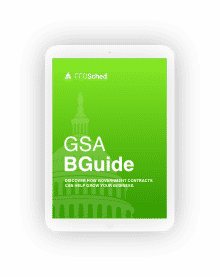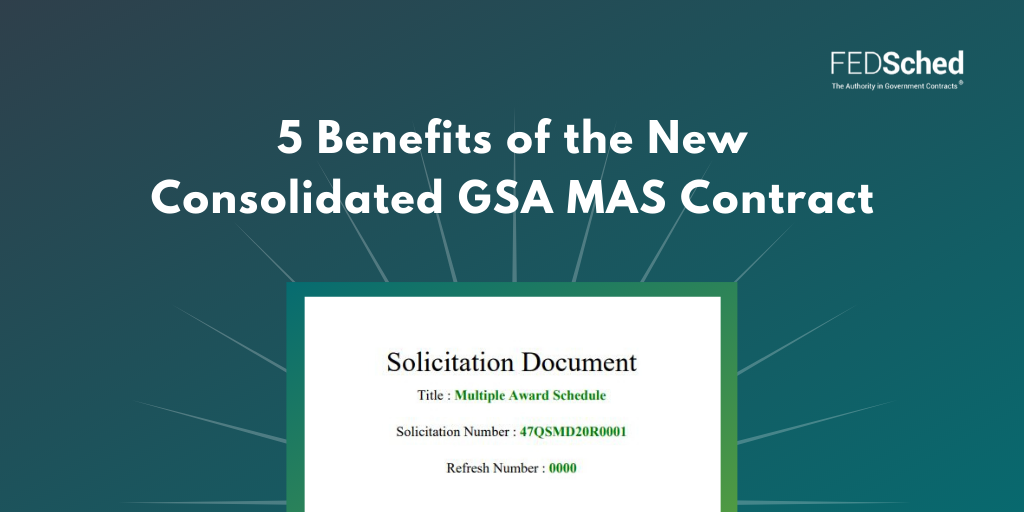GSA kicked off the 2020 government fiscal year with the release of the new, Consolidated GSA Multiple Award Schedule (MAS). While prospective GSA Schedule contractors have been feeling the impact of the new MAS Contract since October, existing GSA Schedule Contract holders have been largely unaffected. That will change soon as GSA initiates phase 2 of the MAS consolidation.
As part of phase 2, GSA is expected to issue a mass modification to all existing GSA Schedule Contract holders later this month. The mass modification will transition your contract to the new, consolidated GSA Multiple Award Schedule. The transition will not affect your pricing, contract number, or contract expiration date. However, if you qualify to offer products or services that were previously under a different Schedule, you’ll have the option to add these offerings to your contract after the migration.
While there may be some hiccups during the transition process, the Consolidated GSA MAS Contract should ultimately benefit both contractors and federal buyers. Below are a few reasons why you should welcome the Consolidated MAS Contract.
5 Benefits of the Consolidated GSA MAS Contract:
❶ Reduced Contract Management – Companies that hold multiple GSA Schedules under the legacy structure will eventually consolidate into one contract and will benefit from reduced administrative costs. As of December 2019, more than 1,600 companies held two or more GSA Schedules. These companies will eventually reduce contract management tasks (including sales reports, contractor assessments, and contract renewals) down to one contract.
❷ Reduced Barrier to Expand Your GSA Schedule Contract – Companies that qualified for multiple GSA Schedules under the legacy structure will benefit from the ability to add on to their existing GSA Schedule, as opposed to pursuing additional GSA Schedule Contracts. Approximately 13% of GSA contractors hold multiple GSA Schedules. However, it’s difficult to estimate how many companies qualified for products or services on additional Schedules, but were put off by the process of obtaining and managing multiple contracts.
❸ Easier for Your Buyer – Prior to the consolidation, you may have found your products or services could qualify under multiple Special Items Numbers (SINs). With over 900 SINs, overlap between SINs was inevitable. If you were unsure where you fell under the GSA Schedule, your potential buyers likely encountered similar difficulties. The new GSA MAS Contract consolidates 24 GSA Schedules and more than 900 SINs into one GSA Schedule with just over 300 SINs. GSA also renamed the SINs to more closely align with their corresponding NAICS code. With less SINs to muddle through, reduced overlap, and improved identification prospective buyers will be more likely to purchase through the simplified MAS Contract and will have an easier time finding you in the process.
❹ Improvements to eBuy – Many GSA Schedule contractors are familiar with the frustration of trying to track an opportunity that’s been put out on eBuy. If the agency doesn’t release the opportunity under a SIN you hold, you won’t be able to find the opportunity let alone submit a bid for it through eBuy. As part of the MAS Consolidation, eBuy will be revamped to match the new Schedule structure. GSA also intends to allow agencies to issue RFQ’s for a Large Category or Subcategory — avoiding the need to review hundreds of SINs to find the best fit and reducing the potential for contractors to miss out on opportunities.
❺ Transactional Data Reporting (TDR) – The MAS Consolidation will benefit companies that hold multiple GSA Schedules where one, but not all contracts are subject to TDR. If you’re not familiar with TDR, it’s a pilot program that frees companies from the burden of the Price Reduction Clause (PRC). In exchange for reporting transactional-level sales data on a monthly basis, TDR exempts companies from following the PRC and Commercial Sales Practices (CSP) tracking and reporting requirements. TDR is only available to companies that hold specific SINs; however if you hold one SIN subject to TDR, your entire contract is subject to TDR. So, companies with multiple GSA Schedules can bring all of their contracts under the TDR umbrella after they consolidate their Schedules later this year.
The GSA MAS Consolidation — as would any other overhaul of this magnitude — will present hurdles for contractors and GSA Contracting Officers during the transition process. However, the goal of the Consolidation is to modernize a decades old contract vehicle that accounts for over $30 billion in annual contract awards across multiple federal agencies.
Get Help & Benefit From the Consolidated MAS Contract
Our team here at Federal Schedules, Inc. can help you navigate the transition and benefit from the changes. Contact us for assistance.

